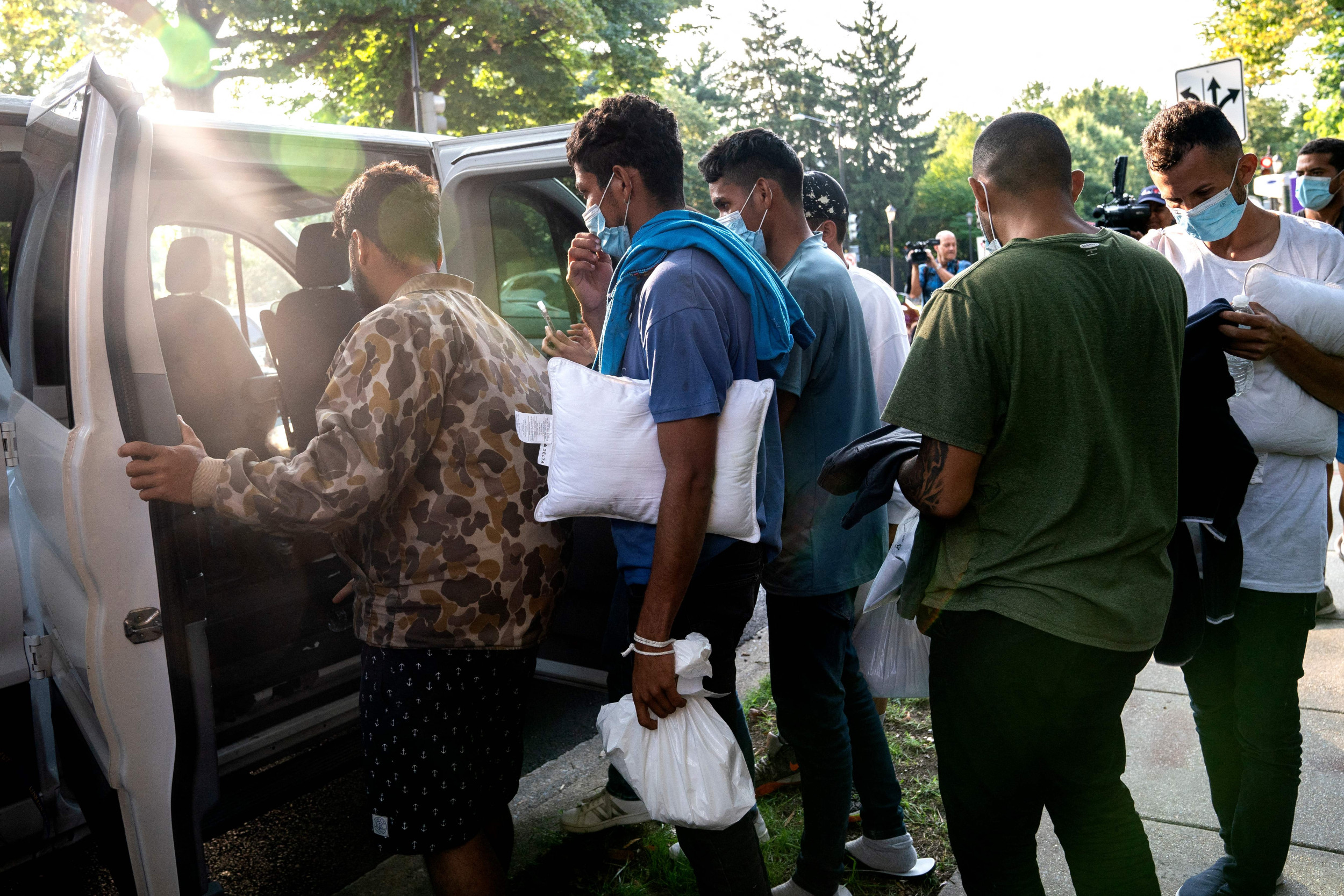By Jeff Young
Environment and Sustainability Editor

People walking the streets of downtown Petaluma, California, started seeing something new on the sidewalks in summer. Alongside the usual trash cans and recycling containers were large purple bins with small openings the size and shape of a drinking cup.
Patrons of the 30 or so downtown restaurants, cafés and coffee shops participating also started getting their carry-out drinks in durable cups the same shade of purple. The color-coordinated cups and bins were part of the Petaluma Reusable Cup initiative. The first-of-its-kind experiment aims to scale up reusable cups and reduce single-use plastics that too often wind up as waste, clogging rivers, killing marine wildlife and risking human health.
"There are a lot of people anxious about our future and concerned about the amount of plastic that we're using as a society, and one of the cures for that anxiety is action," Patrick Carter told Newsweek. Carter is the assistant to the city manager for Petaluma, a city of about 60,000 people roughly an hour's drive north of San Francisco.
In the three months of the privately funded pilot project, organizers said 200,000 cups were put in bins to be collected, washed, sanitized and returned to businesses for another use.
"We have enough data now to know that this has been a successful experiment," Kate Daly, a managing partner at the investment firm Closed Loop Partners, told Newsweek. Daly leads the company's Center for the Circular Economy, which set up the Petaluma project with funding from the NextGen Consortium, a global group including Starbucks, McDonald's, Coca-Cola, Pepsi and other companies working to reduce waste from food service packaging. Their funding made it easier for Carter and local businesses to try out the cost-free program.

Daly said the project provided valuable information about how to best design a large-scale system, and how to effectively communicate reuse to the public. No one is under the impression that just reusing cups will solve a problem as massive and complex as plastic waste. But container reuse is one of many solutions in consideration as the United Nations convenes final negotiations on a Global Plastics Treaty underway in Busan, South Korea.
"The treaty is incredibly important in terms of drawing public attention to the issue of plastic pollution and plastic waste in a way that drives toward solutions rather than just confusion or despair," Daly said.
A 2021 survey conducted by the World Wildlife Fund found 72 percent of Americans expressed frustration about the plastic waste that ended up in oceans, and 81 percent said they wanted to recycle and reuse more of the plastic they buy. But one in seven respondents said they lacked access to adequate recycling services and other surveys found deep dissatisfaction with recycling.
The U.N. treaty process, now in its second year, has brought urgency and focus to work by researchers, community and company executives to scale up reuse, improve recycling and find ways to keep plastics where they belong. Leaders in business, academia and nonprofit groups Newsweek spoke with described a "once-in-a-lifetime" opportunity to put into place systems that could transform the industry and build a circular plastics economy.
Oceans of Waste
The scale of humanity's plastic use and plastic waste is hard to comprehend. A study from 2020 estimated that the total amount of plastic in the world would outweigh all animal life. And of that mass of plastic, the United Nations Environment Programme estimated that about a third produced each year is for single-use products such as wrappers, packaging, bottles and bags. Too much of that ends up as waste that makes its way into waterways and, ultimately, the oceans, where it can persist for decades or, in some cases, centuries.

The International Union for the Conservation of Nature, the world's largest environmental network with more than 1,400 member organizations, estimated that 14 million tons of plastic enter the ocean every year, making up 80 percent of all marine debris.
Douglas McCauley, a professor of ocean science at the University of California, Santa Barbara, said the reach of that waste became apparent when he collected plastic debris from the nests of seabirds on islands in the Pacific, more than 1,000 miles from mainland.
"I think that plastic pollution has grown to become the new cancer for the sea," McCauley said. "You have whales that are consuming millions of microplastic particles in the course of a day by swallowing plankton."
Beyond the effects on large animals, including entanglement, poisoning and more, McCauley said he worries about what plastic waste is doing to the tiniest forms of marine life that make up the base of the ocean's food system.
"We have really no idea what the loss of the bottom of the food chain means, that's almost surely being impacted by these microplastic and nanoplastic pieces," he said. "I don't think it's an overstatement to say the future of the ocean is at stake."

It's not just the oceans at stake. Plastic manufacturing also has a significant impact on our climate. Because most plastics are made from petrochemicals, their manufacture emits greenhouse gases into the atmosphere. Researchers at the Lawrence Berkeley National Laboratory found that production of the major types of plastic polymers accounted for about 5 percent of total global greenhouse gas emissions—more than the aviation sector.
A growing body of research also points to human health impacts associated with exposure to some components of plastics. Dr. Leonardo Trasande is a professor of pediatrics at New York University and directs the NYU Langone Center for the Investigation of Environmental Hazards. Trasande is also an official observer in the U.N. Plastics Treaty talks representing the Endocrine Society, an organization of more than 18,000 scientists and clinicians focused on how chemicals used in plastics affect hormone function.
"We assume that when we see plastic in the ocean we aren't affected," Trasande told Newsweek. But his research and many other studies link chemicals such as phthalates and bisphenols used in some plastics to a range of health effects, including developmental problems in children, obesity and diabetes.
"We have strong evidence for human health effects across a small subset of these chemicals, which unfortunately tells us there might be a bigger problem than what we even know now," he said.
Since the U.N. treaty process started in 2022, Trasande said there has been a "sea change" as the discussions expanded in scope from simply waste reduction to include human health concerns.

McCauley likewise said progress in the treaty talks has made him "cautiously optimistic" about the potential to elevate the patchwork success in some countries and U.S. states and cities to a unified effort big enough to meet the scale of a challenge as big as the plastic waste crisis. "It's a global problem, so it requires a global solution," he said.
He and his colleagues have developed a machine learning model to determine the possible waste reductions from combinations of different approaches under consideration in the treaty talks.
"What we've really found is that there is no silver bullet," UCSB marine scientist and policy specialist Neil Nathan said. "It is really an entire suite of these policies that are going to be needed and that we would really like to see in the treaty."
McCauley and researchers at UCSB and University of California, Berkeley published their findings recently in weekly journal Science. On a business-as-usual course, they found plastic waste worldwide will nearly double by 2050, reaching 121 million metric tons. The annual greenhouse gas emissions from that plastic production would soar by 37 percent.
However, the authors found that a combination of just four policy approaches could reduce emissions from plastics by a third and slash plastic waste by 90 percent by mid-century. Those include a recycling mandate; a packaging tax; investment in waste management and recycling infrastructure; and, perhaps most critically, an agreement to cap the production of new plastics at 2020 levels.
"Plastic is a valuable material, I think we all recognize that," McCauley said, noting the important role of plastics in lifesaving medical devices and more efficient autos. "But its most useful and most important purpose in society and the economy is not making a straw that we use for 35 seconds and has a lifespan of 350 years in the environment."
To drive home his point, McCauley presented U.S. negotiators in the U.N. treaty with a gift: a sampling of the bottle caps, cigarette lighters and plastic debris he had collected from seabird nests on the Midway Atoll.
Business Progress
For the past dozen years, Erin Simon has been building partnerships between businesses that deal with plastics and environmental groups. Simon has a background in the corporate world—she was a packaging engineer at HP—and now puts her business ties to work at the World Wildlife Fund, where she is vice president and head of plastic waste and business.

"We are not able to manage the plastic we have today," Simon told Newsweek, adding that projections from industry analysts show plastic production at the current rate of growth will double by 2040. "We're not going to be able to catch up with what we're producing."
WWF is an environmental nonprofit, but the group has allies in the private sector—some 250 members of the Business Coalition for a Global Plastics Treaty, which Simon helped to form. Simon said the companies realize they can't meet their own goals to cut plastic waste by simply acting alone.
"There are a lot of companies out there that have a ton of public commitments about using recycled content and getting their products recycled," she said. "It is very difficult for that to happen if infrastructure doesn't exist and if policies don't exist and if collection doesn't exist."
Simon said a treaty with global reach could boost funding for recycling and allow adoption of universal designs for plastic products and the elimination of problematic materials—key measures to improve plastic recycling.
"We need recycling systems that work," she said. "Today, they are broken."
The U.S. Environmental Protection Agency said that while recycling of a few types of plastic containers, such as the hard plastic PET jars and HDPE bottles, approaches 30 percent in the U.S., the recycling rate for all plastics is less than 9 percent.
"I don't want to say that plastic recycling is broken, I would say that plastic recycling is growing up," U.S. Plastics Pact CEO Jonathan Quinn told Newsweek.
Plastics Pact is a collection of companies and organizations across the industry value chain working toward a circular economy for plastics.
"The challenges are different than when the recycling system was designed and developed many years ago," Quinn said. Quinn is a second-generation plastic industry professional whose father worked in plastic packaging, and he met his wife at a plastic industry event. "My life has revolved around it," he said.
As Quinn sees it, part of his work is about correcting some mistakes the previous generation made.
"My dad didn't ever worry about the impact of packaging in the environment," he said. "It wasn't what they thought about."

In June, the Plastics Pact released its second "roadmap," a series of goals to cut plastic waste and improve recycling by 2030. This emphasized reuse initiatives like the Petaluma Reusable Cup Project as a key strategy, as well as design that encourages packaging that is reusable, recyclable or compostable.
The industry players in the Plastics Pact also want to eliminate what are called "problematic plastics." That includes a long list of materials that are unnecessary, such as straws and stirrers; some chemicals that might threaten human health; and others that make it harder to recycle or compost waste. Quinn said those measures, along with meaningful requirements for recycled content, can help make recycled plastics more affordable. That economic shift is the key, he said, to boosting recycling and cutting plastic waste.
"We've got to get the price of recycled content in plastics to be as close to the cost of virgin in order to make it financially viable," he said.
A 'Reboot' for Recycling
The gap between industry promises around recycling and the rate of actual recycled content has eroded public confidence and sparked a wave of lawsuits against companies in the plastics value chain. Harris Poll data released in November by pro-recycling group Keep America Beautiful found that 63 percent of people give the nation's recycling performance a "C" grade, with 22 percent rating it a "D" or "F."
When New York Attorney General Letitia James sued PepsiCo and Frito-Lay last year, for example, the lawsuit called out PepsiCo for repeated public claims that recycling will "keep the material in the circular economy" and "ensure that the valuable materials that are used in packaging are recycled and reused, rather than becoming waste."
However, the attorney general maintained that many of the company's food wrappers are not recyclable, and bottles can only be recycled a limited number of times. Newsweek contacted PepsiCo for comment.
New York Judge Emilio Colaiacovo recently dismissed the case, but last month Los Angeles County sued PepsiCo and Coca-Cola, making similar arguments that the companies misled the public about the recyclability of their packaging. The beverage companies have denied the allegations.

In a statement to Newsweek, PepsiCo said the company "remains serious" about plastic reduction and effective recycling. "We will continue to collaborate with key partners to advance smart material collection policies, improve recycling infrastructure, boost consumer awareness about the importance of recycling and establish partnerships focused on reducing waste and exploring innovative solutions to plastic pollution," the statement said.
In September, California Attorney General Rob Bonta sued ExxonMobil for what he called a "campaign of deception" promoting so-called advanced recycling, which uses high heat and chemical processes to break down plastics. In a statement to Newsweek, ExxonMobil said: "Instead of suing us, they could have worked with us to fix the problem and keep plastic out of landfills."
Kate Bailey is chief policy officer for the Association of Plastic Recyclers, a 30-year-old trade group. She said the lawsuits are likely providing some motivation for companies to work harder for solutions.
"Litigation is always a concern, but really it's just the public pressure," Bailey said. "The public is mad about plastics on many, many levels and companies across the board are responding to that in a variety of ways."
Bailey has worked in recycling for 20 years, and bristles a bit at the notion that plastic recycling is broken. "Plastics recycling works each and every day across the U.S.," she said. "It just needs to work a lot better." Recycling rates for all materials has stagnated, she added, and recycling is "really in need of kind of a reboot."
All forms of recycling suffer economic challenges, Bailey continued, but plastic recycling is also hampered by what she called "wish-cycling," wherein consumers place objects in recycling bins that can't be recycled. That's where product design comes into play, like the recycling bins in Petaluma with openings that match the shape and purple color of the cups.
"The burden cannot be on the consumer," she said. "There is too much confusion around what can be recyclable."

Bailey said the U.N. treaty is an opportunity to "harmonize" global design rules for plastics so that more materials are recyclable. She said extended producer responsibility policies, or EPRs, can help shift the costs of plastic collection to the producers to pay for recycling, proper waste management and refilling programs such as the one tested in Petaluma. And she echoed Quinn's call for policies that put recycled plastic materials on an even economic footing with virgin plastics.
"The U.N. work toward the Global Plastics Treaty is absolutely a tipping point in how we manage, consume and dispose of plastic," she said. "I think a few years down the road, we're really going to look back at this as a moment when a massive shift happened."

![]()
fairness meter
fairness meter
Newsweek is committed to journalism that's factual and fair.
Hold us accountable and submit your rating of this article on the meter.
Newsweek is committed to journalism that's factual and fair.
Hold us accountable and submit your rating of this article on the meter.
Click On Meter To Rate This Article
To read how Newsweek uses AI as a newsroom tool, Click here.



















 English (US) ·
English (US) ·